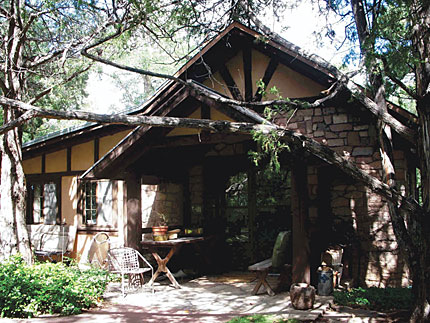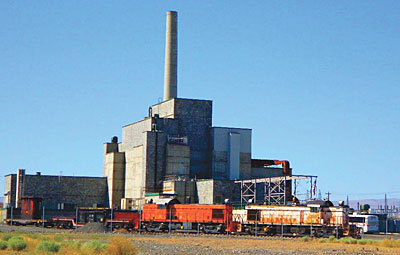New park will honor US atomic heritage
DOI: 10.1063/PT.3.2715
A 15-year effort to save sites and buildings vital to the Manhattan Project as a national historic park paid off in December when President Obama signed the fiscal year 2015 National Defense Authorization Act. Tucked into the massive legislation was a provision instructing the Departments of the Interior and Energy to have the park open within one year.
The two agencies were told to conclude a memorandum of agreement delineating the roles of each in creating and maintaining the park. Interior’s National Park Service (NPS) will most likely operate the park, which comprises World War II–era structures at the three locations where most of the development of the atomic bomb took place: Los Alamos, New Mexico; Oak Ridge, Tennessee; and Richland, Washington. DOE, which owns all the facilities, is expected to maintain them, says Cynthia Kelly, founder and president of the nonprofit Atomic Heritage Foundation (AHF). Kelly was the major force behind the park’s creation; she took early retirement from DOE in 2002 and has been lobbying for the park ever since.

J. Robert Oppenheimer’s former home in Los Alamos, New Mexico, remains occupied but is open to the public at times. On the departure of the current owner, it will become a permanent part of the newly authorized national park honoring the Manhattan Project.
ATOMIC HERITAGE FOUNDATION

“The park service is America’s storyteller, and they will be the ones to take on this contested history and tell it in a way that will ask people to use their critical thinking, learn about the circumstances in the context of World War II, and think through the ambiguities and complexities of what happened,” says Kelly. She notes that the new park will be one of only a few among the NPS that recognize industry.
Saved from the bulldozer
The park won’t be fully formed in one year; the legislation designates more than 40 specific sites, many of them located in areas that are now secured. Public access arrangements will have to be worked out, and some may be available only on a limited basis. But each of the three locales already has facilities that are open to the public, including the B Reactor on the Hanford Site near Richland, where the plutonium for the Fat Man bomb dropped on Nagasaki was produced; the Fuller Lodge social center and the homes of J. Robert Oppenheimer and Hans Bethe at Los Alamos; and the calutrons at the Oak Ridge Y-12 National Security Complex, which enriched uranium-235 for the Little Boy weapon detonated over Hiroshima. Each of the three locations has at least one atomic museum.

The B Reactor at the Hanford Site in Richland, Washington, produced plutonium for the first nuclear test device and for the Fat Man bomb dropped on Nagasaki in 1945.
ATOMIC HERITAGE FOUNDATION

Many of the new park’s 17 cabins and other small structures at Los Alamos National Laboratory had been due to be razed. They are located at the V Site, where ”the gadget,” the plutonium implosion device detonated in the Trinity test, was assembled, and at the Gun Site, where Little Boy was put together. Included is the building where Louis Slotin received a fatal dose of radiation while performing a post-war criticality experiment.
Richard Rhodes, author of The Making of the Atomic Bomb and an AHF board member, says that writing history requires more than poring over documents. “When it’s possible, you need to walk the ground. There is a reality to the physical structure of historical artifacts that is of a different order from looking at documents,” he says. “This immense historic process that went on in exploring the energy release from nuclear fission will be there for people to think about and look over.”
The park isn’t a celebration of the US invention of the bomb, he says. “It’s really something more, just as the preservation of Auschwitz and the preservation of American Civil War battlefields is also for a much more serious purpose. It’s an acknowledgment of the fact that it was.”
No funding was authorized by the legislation. The NPS has estimated $2.5 million to $4 million is needed annually to operate the park and to offer onsite historical interpretation. The Obama administration included $180 000 for the park in its fiscal year 2016 budget request, released last month.
Some sites left out
The list of sites to be included in the park’s inventory evolved over time, says Kelly. In 2001, DOE officials designated certain “signature facilities” of the Manhattan Project. Several of those are part of the park: at Hanford, the B Reactor and the adjacent T Plant chemical separation facility; at Oak Ridge, the calutrons and the X-10 graphite reactor; and at Los Alamos, the V and Gun Sites. The remaining facilities on the list are not part of the park: The mile-long K-25 gaseous diffusion uranium enrichment plant at Oak Ridge has been demolished; Chicago Pile-I, the world’s first manmade nuclear reactor, is long gone; and the Trinity site at the US Army’s White Sands Missile Range in New Mexico is open to the public only one day a year.
Working under a DOE grant and with input from DOE, the NPS, state and local governments, and the public, the AHF developed a preservation plan in 2003. The NPS then evaluated the significance, structural integrity, and potential for public enjoyment of the properties.
Kelly’s foundation has done some of the advance work for NPS; for a few of the major facilities it has already put together a smartphone-accessible self-guided tour, which she calls “ranger in your pocket.” The AHF also offers to the public hundreds of hours of recorded interviews with major wartime atomic figures, including Leslie Groves, the army general who headed the Manhattan Project, and Oppenheimer, its scientific director.
The park boundaries will be expanded in the future, Kelly predicts, to encompass labs at the University of California, Berkeley, where Glenn Seaborg discovered plutonium, and at the University of Chicago, where Enrico Fermi did foundational work on nuclear reactors. “We’re not going to forget about those,” she promises.
More about the Authors
David Kramer. dkramer@aip.org
